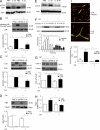TAK1 in brain endothelial cells mediates fever and lethargy
- PMID: 22143887
- PMCID: PMC3244031
- DOI: 10.1084/jem.20110398
TAK1 in brain endothelial cells mediates fever and lethargy
Abstract
Systemic inflammation affects the brain, resulting in fever, anorexia, lethargy, and activation of the hypothalamus-pituitary-adrenal axis. How peripheral inflammatory signals reach the brain is still a matter of debate. One possibility is that, in response to inflammatory stimuli, brain endothelial cells in proximity to the thermoregulatory centers produce cyclooxygenase 2 (COX-2) and release prostaglandin E2, causing fever and sickness behavior. We show that expression of the MAP kinase kinase kinase TAK1 in brain endothelial cells is needed for interleukin 1β (IL-1β)-induced COX-2 production. Exploiting the selective expression of the thyroxine transporter Slco1c1 in brain endothelial cells, we generated a mouse line allowing inducible deletion of Tak1 specifically in brain endothelium. Mice lacking the Tak1 gene in brain endothelial cells showed a blunted fever response and reduced lethargy upon intravenous injection of the endogenous pyrogen IL-1β. In conclusion, we demonstrate that TAK1 in brain endothelial cells induces COX-2, most likely by activating p38 MAPK and c-Jun, and is necessary for fever and sickness behavior.
Figures



Similar articles
-
Heat shock protein 90 (Hsp90) regulates the stability of transforming growth factor beta-activated kinase 1 (TAK1) in interleukin-1beta-induced cell signaling.Mol Immunol. 2009 Feb;46(4):541-50. doi: 10.1016/j.molimm.2008.07.019. Epub 2008 Oct 31. Mol Immunol. 2009. PMID: 18950863
-
AICAR induces cyclooxygenase-2 expression through AMP-activated protein kinase-transforming growth factor-beta-activated kinase 1-p38 mitogen-activated protein kinase signaling pathway.Biochem Pharmacol. 2010 Oct 15;80(8):1210-20. doi: 10.1016/j.bcp.2010.06.049. Epub 2010 Jul 6. Biochem Pharmacol. 2010. PMID: 20615388
-
Transforming growth factor-β-activated kinase 1 regulates angiogenesis via AMP-activated protein kinase-α1 and redox balance in endothelial cells.Arterioscler Thromb Vasc Biol. 2013 Dec;33(12):2792-9. doi: 10.1161/ATVBAHA.113.301848. Epub 2013 Sep 26. Arterioscler Thromb Vasc Biol. 2013. PMID: 24072697
-
IL-1β mediates NGF and COX-2 expression through transforming growth factor-activating kinase 1 in subacromial bursa cells derived from rotator cuff tear patients.J Orthop Sci. 2019 Sep;24(5):925-929. doi: 10.1016/j.jos.2019.02.006. Epub 2019 Feb 22. J Orthop Sci. 2019. PMID: 30799163
-
Microglial-specific depletion of TAK1 is neuroprotective in the acute phase after ischemic stroke.J Mol Med (Berl). 2020 Jun;98(6):833-847. doi: 10.1007/s00109-020-01916-9. Epub 2020 May 7. J Mol Med (Berl). 2020. PMID: 32382778 Free PMC article.
Cited by
-
Cerebral angiogenesis ameliorates pathological disorders in Nemo-deficient mice with small-vessel disease.J Cereb Blood Flow Metab. 2021 Feb;41(2):219-235. doi: 10.1177/0271678X20910522. Epub 2020 Mar 9. J Cereb Blood Flow Metab. 2021. PMID: 32151223 Free PMC article.
-
Endothelial TDP-43 depletion disrupts core blood-brain barrier pathways in neurodegeneration.Nat Neurosci. 2025 May;28(5):973-984. doi: 10.1038/s41593-025-01914-5. Epub 2025 Mar 14. Nat Neurosci. 2025. PMID: 40087396 Free PMC article.
-
The SARS-CoV-2 main protease Mpro causes microvascular brain pathology by cleaving NEMO in brain endothelial cells.Nat Neurosci. 2021 Nov;24(11):1522-1533. doi: 10.1038/s41593-021-00926-1. Epub 2021 Oct 21. Nat Neurosci. 2021. PMID: 34675436 Free PMC article.
-
Validation studies and multiomics analysis of Zhx2 as a candidate quantitative trait gene underlying brain oxycodone metabolite (oxymorphone) levels and behavior.J Pharmacol Exp Ther. 2025 May;392(5):103557. doi: 10.1016/j.jpet.2025.103557. Epub 2025 Mar 21. J Pharmacol Exp Ther. 2025. PMID: 40215834
-
Characteristics of blood-brain barrier heterogeneity between brain regions revealed by profiling vascular and perivascular cells.Nat Neurosci. 2024 Oct;27(10):1892-1903. doi: 10.1038/s41593-024-01743-y. Epub 2024 Aug 29. Nat Neurosci. 2024. PMID: 39210068 Free PMC article.
References
-
- Ching S., Zhang H., Belevych N., He L., Lai W., Pu X.A., Jaeger L.B., Chen Q., Quan N. 2007. Endothelial-specific knockdown of interleukin-1 (IL-1) type 1 receptor differentially alters CNS responses to IL-1 depending on its route of administration. J. Neurosci. 27:10476–10486 10.1523/JNEUROSCI.3357-07.2007 - DOI - PMC - PubMed
Publication types
MeSH terms
Substances
LinkOut - more resources
Full Text Sources
Other Literature Sources
Medical
Molecular Biology Databases
Research Materials
Miscellaneous

